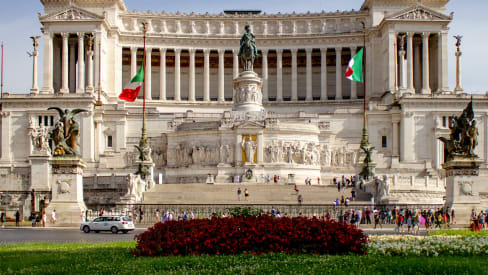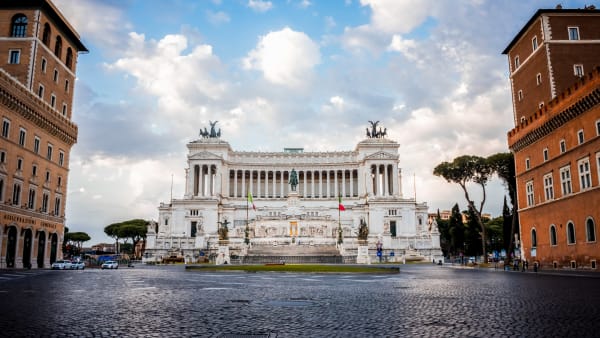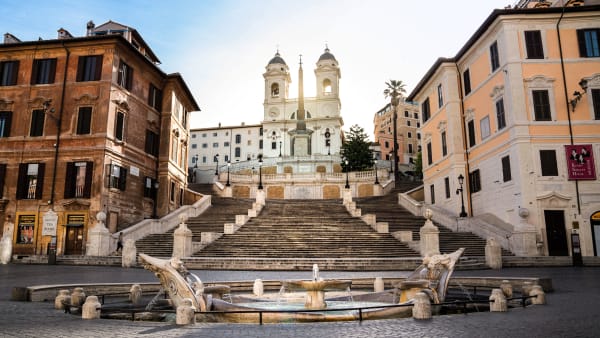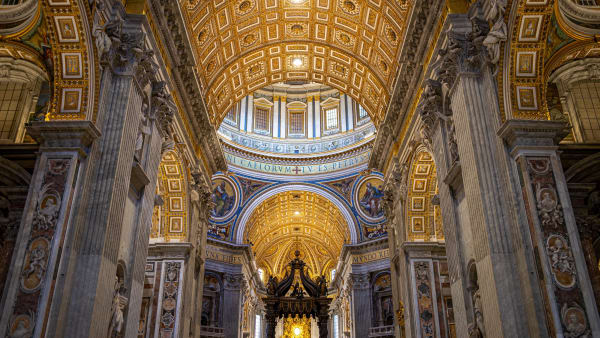Curiosities
Curiosities
Not even the spectacular monument in Piazza Venezia was able to escape Roman satire and humor. Here you will find out what names Romans generally use to refer to it, together with many other interesting details, for instance, the location of Michelangelo’s humble house, where he lived until his death.
The Vittoriano: the biggest typewriter in the world
As mentioned in the previous section, the monument has long been mythologized as the temple of the national spirit, the essence of the values of freedom, patriotism, and unity.
Respected and valued, this piece has also been questioned more than once, both ideologically, aesthetically, and urbanistically. This is because many buildings dating back to Mediaeval Rome were taken down to make room for it. In fact, the whole floor plan of Piazza Venezia had to be reassessed. Because of this, the initial budget of 9 million liras was not respected, with the final cost reaching 26,5 million.
It is also often negatively associated with Fascism, even if the monument was built in the last decades of the 1800s, long before Mussolini declared himself Head of State, at the beginning of the 1920s. This association derives from the fact that Fascism, in a rather pompous (and predictable) way, appropriated many of the values represented in the monument.
In light of this, the Vittoriano ended up being scorned by Romans and thus nicknamed the typewriter or wedding cake. These terms aim to make fun of its color, shape, and maybe excessive dimensions. Regardless of these associations, the Monument is one of the most important works of art from the Italian Unification.
The Unknown Soldier
In this article, the figure of the Unknown Soldier has often been mentioned, due to its importance with regards to the Altar of the Fatherland and the Vittoriano in general. It is therefore important to clarify its role and history.
It is an ode to an Italian soldier who died during WWI, whose body was unrecognizable due to serious injuries. He became the symbol of the Fatherland and the Italians who died or were lost at war.
The tomb of the Soldier was built as a reminder and warning after World War I, and it is located inside the Altar of the Fatherland. Two armed soldiers and two perpetual flames stand guard.
The body, chosen among eleven others by a woman from the Italian city of Trieste, Maria Bergamas, who had lost her son in the war. The corpse was transferred to Rome amidst two wings of people. The coffin was placed here on the 4th November 1921, National Unity and Armed Forces Day in Italy.
Arrived in Rome after crossing Italy, the tomb of the National Hero went up the steps of the Vittoriano, carried by 12 soldiers who had been decorated with the Gold Medal for Military Valour.
In the background, stood the Regimental Flags of those that had participated in the war, the troops deployed, the veterans, the wounded, and a large crowd. That day, the Unknown Soldier became the symbol of the 650,000 fallen in the Great War, as well as all those who had died for the Fatherland.
Benito Mussolini’s Speech
On the 10th of June 1940 at 6 pm, from the balconies of the Venice Palace, Mussolini announced he had declared war on France and England.
With insidious cunning and knowledge of the media, the speech was transmitted through RadioMarelli in the major Italian cities: Genoa, Turin, Milan, Venice, Trieste, Bologna, Forlì, Bari, Florence, and Naples. Where Mussolini’s body couldn’t go, his metallic voice took his place.
According to some stories, he had practiced in front of the mirror, in his military suit. Abroad, his announcement had been expected for a few days. In Italy, instead, the news spread at the last minute: the radio and the hastily hung posters informed the public that the duce (a term with which Mussolini wanted to be referred to, meaning commander or leader) would have spoken to them. In the last few days, the propaganda had increased heavily.
What led Mussolini to bring Italy into a catastrophe? He was totally aware of the country’s military lack of preparation. He had encountered resistance from many sides. According to Renzo Felice, a well-known biographer of his, the reasons that moved him were mainly two. France was on its knees, overwhelmed by German forces. Mussolini’s fear of Germany was great at this point. In fact, it is reported that he had exclaimed “We cannot step back. After France, it might be our turn”.
With that speech, Mussolini brought an entire country to ruin. “There lies the tragedy of Italian history”, said Churchill a few months later from a London Radio, “and there stands the criminal”. A judgement hard to refute.
Saint Mark’s Palace Garden: Palazzetto Venezia
Many believe that Venice Palace (Palazzo Venezia) and Palazzetto Venezia are the same. In reality, the latter indicates a structure dating back to the 1400s, initially known as Saint Mark’s Palazzetto. It had an interior courtyard, conceived by Paul II in 1464 as an open garden surrounded by a porch, to which an upper gallery was added in 1466-68.
In 1770, under Paul III’s orders, 21 arches were closed. This started a process of alterations to the complex, so significant that they would change its overall appearance. The building then came to be known as Palazzetto. Demolished in 1909, to make room for the Vittoriano, it was rebuilt in 1911-12, repurposing the same stone materials.
The interior courtyard has two rows of arches, and opposite, octagonal pillars with composite capitals and columns with Ionic capitals in travertine; in the center, a well, sculpted by Antonio da Brescia.
Currently, the Palazzetto houses some sections of the Museum of Palazzo Venezia and the National Archaeology and History of Art Institute. At the corner of the building, we can find the statue of Madama Lucrezia, a large marble bust commonly known for being one of the *talking statues *of Rome (a series of sculptures on which, since the 16th century, Romans have posted anonymous messages, mostly containing criticism and satirical writings against the powers that be).
The statue is easily identifiable by the isiac knot that ties the scarf on the woman’s chest. This type of knot finds its origins in the cult of the goddess Isis, which was celebrated in Campo Marzio in the II or III century A.D. There was a massive statue of the goddess, wearing the same knot.
The bust was placed here around 1500 by the cardinal Lorenzo Cybo. Initially, it stood in front of the Saint Mark Basilica, then it was moved to the left, where we can find it now. The name of the statue originates, according to tradition, from dame Lucrezia d’Alagno. She was Alfonso d’Aragona’s favorite, (King of Naples), and she lived by the square in the second half of the XV century.
The statue became the protagonist of many popular demonstrations in Rome. On the first of May, during the Ballo dei Poveretti (meaning Dance of the Pauper, a carnival for the lower classes), the statue would be seen wearing garlands made of garlic, chilies, onions, and ribbons. Like the other five talking statues in Rome, Madame Lucrezia was often the protagonist of several Pasquinate, satire pieces against the government or those in power.
Piazza Venezia’s Lion
The façade of Saint Mark’s Palace features arches on the ground floor and a frieze painted in chiaroscuro, dominated by a series of romantic mullioned windows (vertically divided windows). From these, two rows of small windows stand out. Above the main entrance of the prestigious façade is the effigy of the Lion of St. Mark.
The bas-relief dates back to the XVI century, and it comes from the city walls of Padua. It was placed at the center of the façade, as an emblem of Italy’s rebirth and the Republic of Venice.
Michelangelo’s House
In the most secluded spot of Piazza Venezia, in a recess in the proximity of the Trajan Forum, a plaque on the side of the Assicurazioni Generali Palace indicates where Michelangelo Buonarroti’s house once stood.
He had been an Italian sculptor, painter, architect, and poet. Among some of his most famous works, we can name the David, the Moses, the Pietà in the Vatican, the dome of St Peter’s Basilica, and the frescoes in the Sistine Chapel.
The plaque says: “Here was the house consecrated by the dwelling and death of the divine Michelangelo. SPQR 1871”. The structure was located in Via Macel de Corvi, a small and winding street then demolished to allow the construction of the Vittoriano.
Michelangelo lived in this house for half a century. It was given to him in 1513 thanks to his relationship with the Della Rovere noble house, as he was meant to design the statues on the Pope’s tomb in San Pietro in Vincoli church. The project was active for many years, but was never finished, and represented one of the darkest times in the artist’s life.
The house, contrary to Michelangelo’s art, was very humble. It had two bedrooms, the workshop on the ground floor, a dining room, and a cellar. It also had a loggia, a stable, and a vegetable garden. The artist famously lived there “poor and alone like a spirit bound in a bottle”.
The area consisted of a dense network of alleyways in which Rome expressed all its popular soul, for better or for worse. There were numerous landfills nearby. The artist himself, to describe the smell of his neighborhood, jokingly said it seemed as if he lived in a communal latrine.
Despite all this, Michelangelo lived there for a long time, but also produced some of his major works of art, such as the Giudizio Universale (Universal Judgement) o la Pietà (Piety, Mercy). He did not move to another house, even when he became the most well-known and sought-after artist in Rome.
He continued to live in the same house, like a common craftsman, with almost no luxury. It was between those walls that he wrote the letters and sonnets dedicated to Vittoria Colonna and it was in that same house that he fell in love with Tommaso de’ Cavalieri, who stood by his side until his death when he was almost ninety years old.
Piazza Venezia and Cinema
As we have mentioned in some of our articles, Rome has often been chosen by directors as a film set, whether they were depicting Roman culture or not.
One of the most well-known characters in the capital has always been the Traffic Warden, also called Pizzardone, who directed traffic from his platform in the middle of the crossroad.
The ultimate traffic warden is the one standing in Piazza Venezia, considering the square’s central location and the numerous streets that meet there.
This character has been interpreted by numerous actors in many of the films that contributed to the formation of the canon of Italian contemporary comedy. Among these, we find Il Vigile (The Traffic Warden) with Vittorio de Sica and Alberto Sordi. The latter also stars, together with Nino Manfredi in another important film by Mauro Bolognini.
Among other films that chose this location, we can find the latest Mission Impossible, which apparently chose the square for some of its scenes featuring the main talent, Tom Cruise.















